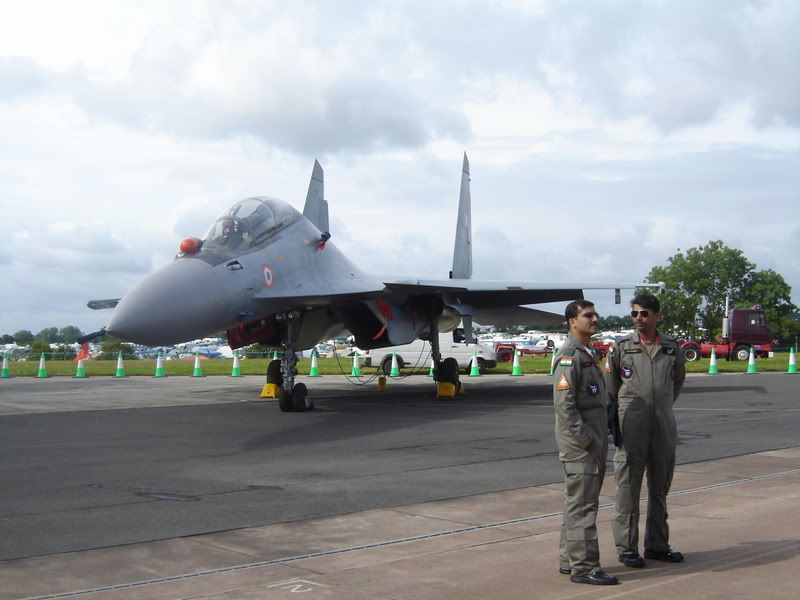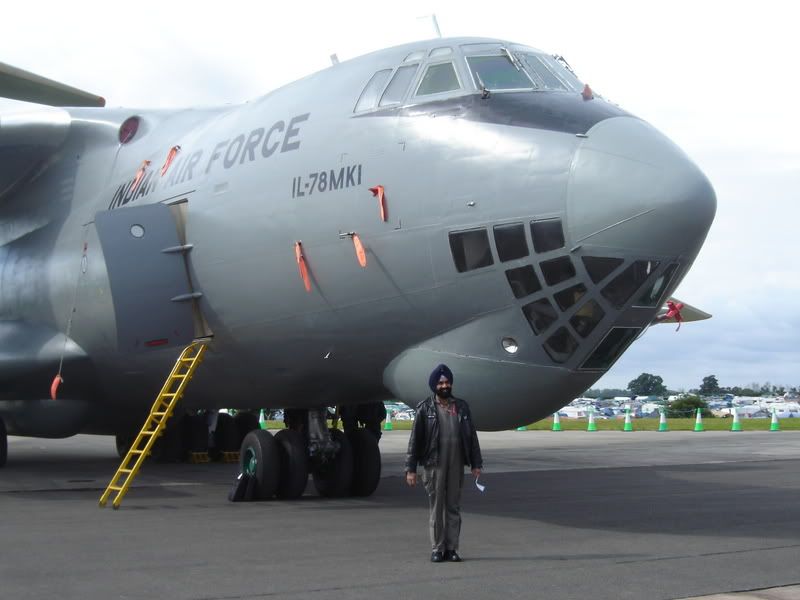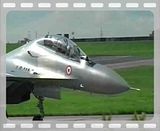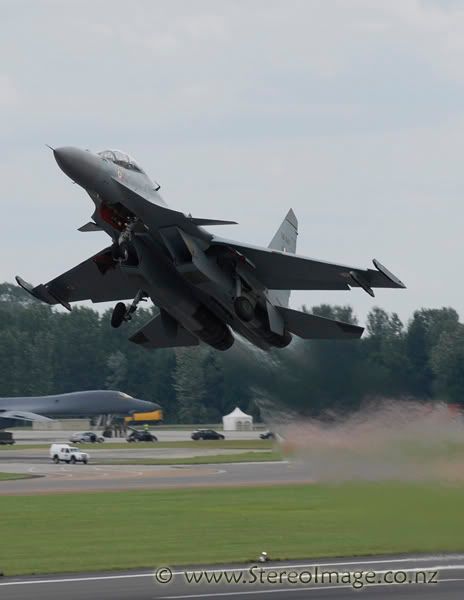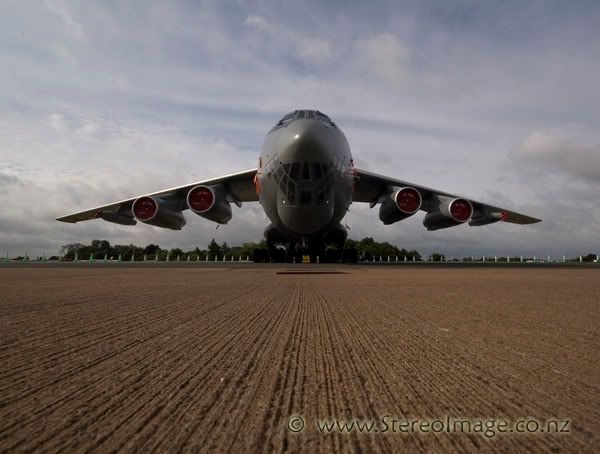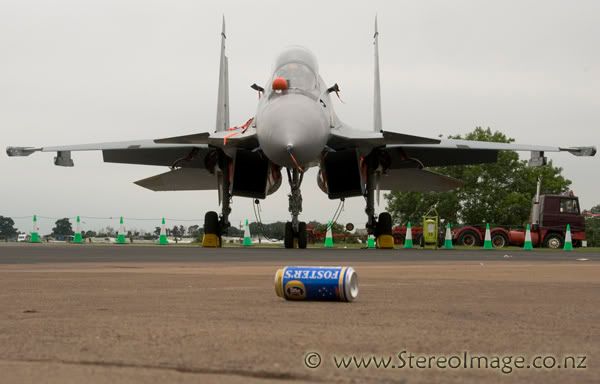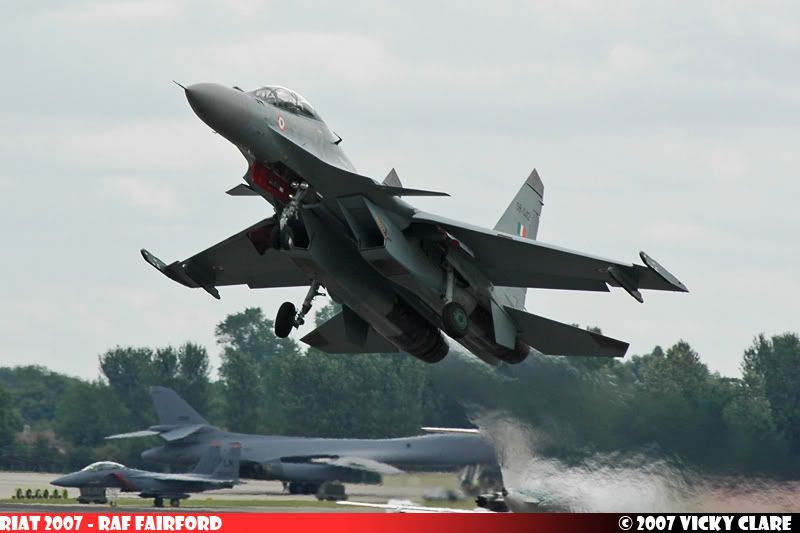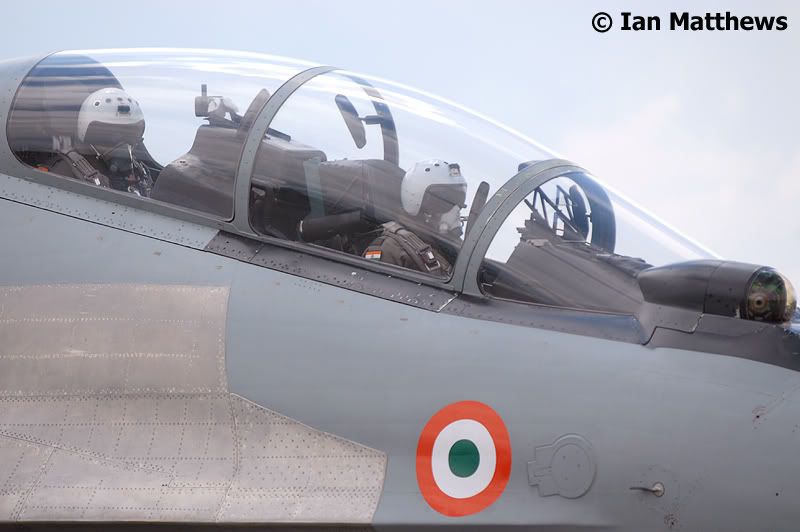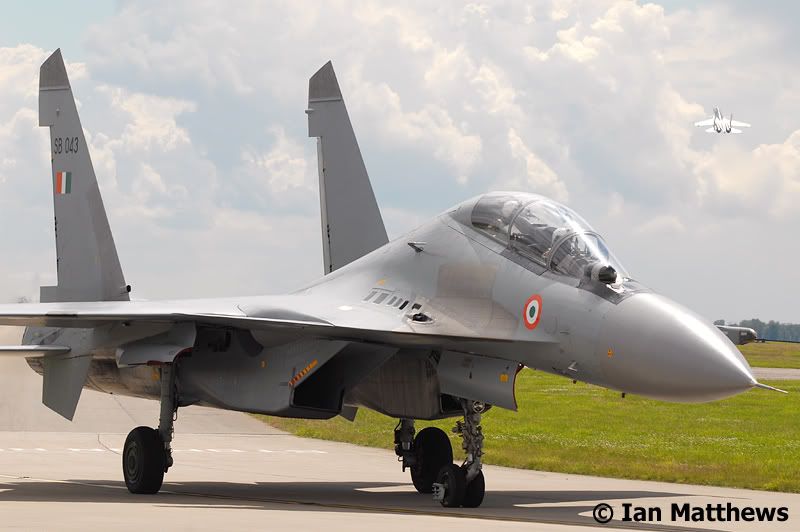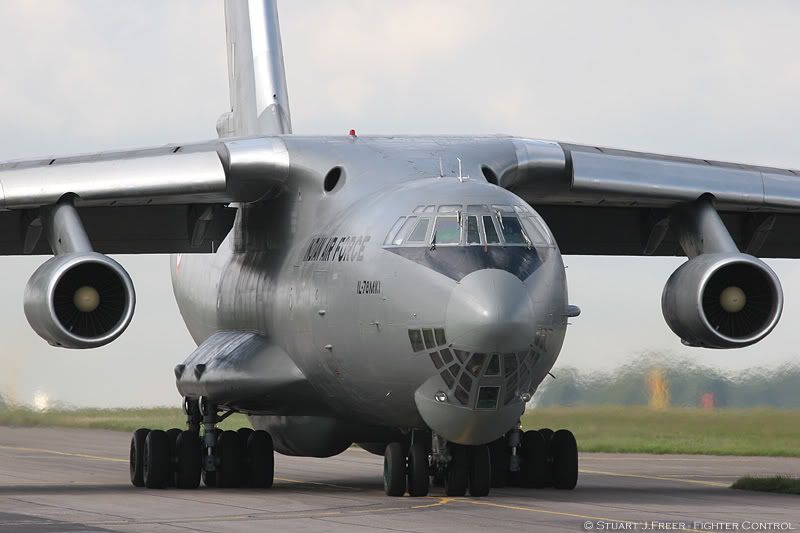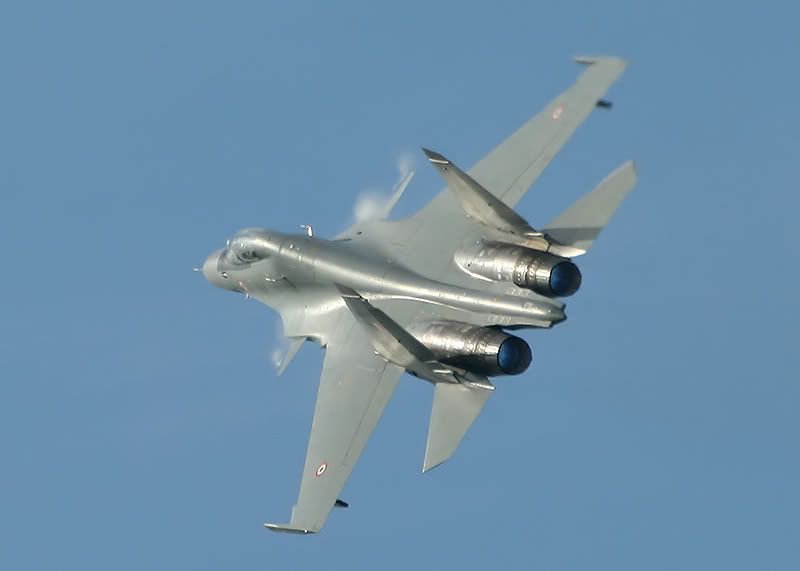Posted: 20 Jul 2007 14:30
Here is an analytic comparison from Ausairpower between the SU-30s and the F-18series and the JSF.There are some excellent charts/maps in the site.http://www.ausairpower.net/APA-Flanker.html
Su-30 vs RAAF Alternatives
Many visitors will be asking the obvious question of how the Sukhois stack up against the F/A-18A HUG, the JSF panacea and recently proposed interim fighters such as the F/A-18E/F.
Against all three types the Su-30 derivatives, especially with later engine subtypes, will always have a significant kinematic advantage - there is no substitute for thrust in the kinematic performance game. There is another factor to consider here, which is the superlative 10 tonnes of internal drag free fuel the Sukhoi carries. When not operating at extended combat radii, the Sukhoi driver has more fuel to convert into energy, and that energy can nearly always be used to an advantage.
With mutually competitive WVR missiles and Helmet Mounted Sights/Displays for close-in combat, all three types will live or die in a close in engagement with an advanced Su-30MK variant by pilot ability and good or bad luck. The Sukhoi combines high alpha manoeuvre capabilities with excellent thrust/weight performance, and is apt to have an energy advantage entering and prosecuting a close in fight. A JSF driver opting to engage a thrust vectoring late model Su-30MK in a knife fight may not survive to speak of the experience, unless the Sukhoi driver is unable to exploit his advantage properly.
In close in air combat terms the JSF qualifies as 'double inferior' against the later model Sukhois, since the Sukhois have an advantage in both thrust/weight ratio and in wing loading (interested visitors refer R.L. Shaw's Fighter Combat), and with its canard and thrust vectoring capability will generally be able to gain a firing solution quicker. Because the JSF is designed within the kinematic performance class of the F/A-18 and F-16, it is right in the middle of the performance envelope of aircraft the Sukhoi was designed to kill.
This chart compares some cardinal design parameters for the Su-30MK series, the JSF and the F/A-18 family, using manufacturer's data. The effective wing loading of the Su-30 is better than depicted, since the aircraft's configuration delivers a considerable amount of body lift. While in the near term the AESAs in the JSF and F/A-18E/F will be competitive, in the longer term the retrofit of AESA technology in the N011M series radar will see the advantage in power aperture go to the Sukhoi - both the JSF and F/A-18E/F are aperture size and cooling capacity limited in growing AESA performance (Author).
In Beyond Visual Range (BVR) combat, the Sukhoi will again have a kinematic advantage, which may be exploitable at the bounds of engagement radii, as the Sukhoi can gain separation in and out of the missile envelope of the F/A-18's and JSF faster - it has the extra thrust and combat fuel to play kinematic games both smaller fighters cannot.
The BVR game is however dominated by sensor capabilities, both onboard and offboard the fighters, and long range missile capabilities. The F/A-18A HUG is wholly outclassed by an Su-30MK with an N011M phased array and R-77M ramjet missile. A late model F/A-18E with minimal external stores and the APG-79 AESA fares much better due to its radar signature reduction measures and better radar power-aperture performance, but with external stores its margin of survivability is eroded and it is likely to fall well within the engagement envelope of the Sukhoi and also come to grief (refer radar/missile plot). A post 2010 AESA equipped Sukhoi could almost certainly take on the F/A-18E with confidence as it will have much better power-aperture capability in the radar, enough to offset the radar signature reduction measures in the F/A-18E/F, with an advanced IRST to supplement radar data.
What happens when the existing OLS-27/30/31 series IRST is replaced with a newer longwave Focal Plane Array device - such as a single chip QWIP device? The result will be a capability to engage opposing aircraft under clear sky conditions regardless of RCS reduction measures. While the supercruising F/A-22A can defeat such techniques by kinematics alone, fighters in the teen series performance envelope will have to contend with BVR shots using the R-27ET, R-77, R-77T and R-77M cued by the thermal imaging search and track set. Similar issues arise with the deployment of modern ESM receivers on the Su-30MK, analogous to a number of existing Western systems. The Su-30MK series can then launch long range BVR missiles such as the R-27ET, R-77T with infrared seekers, or the R-27EP and R-77P with passive radio-frequency anti-radiation seekers. If cued by such sensors or offboard sources, these weapons will permit the Su-30MK to engage the JSF despite the JSF's good forward sector radar stealth performance (Author).
A clean JSF will have the advantage of a very low X-band radar signature in the forward quarter which will significantly degrade the Sukhoi's otherwise overwhelming radar power-aperture advantage over other types. However, the JSF is not designed to be a hot supersonic performer and like the F/A-18s will need to generously use afterburner to effect an intercept against a rapidly penetrating Sukhoi.
This exposes the JSF to detection and tracking by a newer technology IRST, and engagement by a long burn heatseeking or optically guided AAMs such as the R-27ET, R-77T or likely future variants with imaging seekers analogous to the AIM-9R and ASRAAM seekers. With the latter seekers an R-77/R-77M acquires many of the capabilities of the RAAF's superlative ASRAAM, especially jam resistance, but in a long range missile with datalink midcourse guidance. A new two-colour infrared seeker with 10.8 nautical mile acquisition range has been announced by the Arsenal infrared systems house, ostensibly for use on the R-77 series. Professionals might contemplate that these are not 1980s 36T series seekers.
Russia and the Ukraine have a competent infrared systems industry - e.g. Cyclone JSC recently described their QWIP single chip thermal imagers with 128x128 and 320x256 resolution, competitive against the latest EU technology and suitable for missile seekers and thermal imaging IRST detectors. Therefore an advanced derivative of the OLS-30/31 series with capabilities similar to the Eurofighter PIRATE thermal imaging IRST, but with better detection range, will be implementable with Russian hardware in the latter half of this decade given the current rate of evolution.
In the beam and aft sectors the JSF may be also quite vulnerable to an active or semiactive radar guided missile shot - its beam and aft sector radar signature reduction is much less refined than that in the forward sector. Another factor for the JSF is its radar emission - making it vulnerable to a long range shot with an anti-radiation seeker equipped R-27P, R-27EP, R-77P or when eventually deployed, ramjet R-77MP. While some Low Probability of Intercept (LPI) techniques may reduce vulnerability to anti-radiation missiles, radar modes for closing missile shots typically require high update rates and favour the anti-radiation seeker. Since the R-77/R-77M has a midcourse inertial package - Agat are developing FOG (fibre) gyro technology to avoid dependency on Western Ring Laser Gyro technology - transient loss of the JSF radar emission may not defeat the R-77P/R-77MP - or late model R-27P/EP.
Soviet and more recent Russian BVR doctrine has always emphasised firing pairs of missiles, one with heat-seeking guidance and one with radar guidance, to defeat countermeasures. With the option of active radar, heat-seeking and anti-radiation seekers, and by the end of the decade an imaging seeker, the result is a very lethal cocktail from a defensive countemeasures perspective - a defending fighter may only have datalink transmissions to provide warning and no indication of the seeker mix on the inbound missiles. With three of the four seeker technologies passive defeating such weapons is not trivial.
On publicly available data the JSF is likely to be detected and engaged by an N011M ESA equipped Su-30 inside the 10 to 20 nautical miles head on range envelope, unless the JSF can get the first shot off and successfully kill the Sukhoi. If the Sukhoi can close with the JSF, all bets are off on the JSF's ability to survive the close in engagement.
A view commonly heard in Canberra these days is that the use of the Wedgetail AEW&C to provide offboard targeting for the JSF will provide a decisive advantage over the Sukhois - 'Network Centric Warfare' will ostensibly offset all other deficiencies in the force structure and platform capabilities. This argument is clearly contingent upon a great many 'ifs' - if the Sukhois do not shoot very long range missiles at the Wedgetail to force it to shut down or indeed kill it, if the Wedgetail MESA is not jammed, if the JTIDS/MIDS or other datalinks to the fighters are not jammed, if the Sukhois are not carrying advanced IRSTs or X-band homing receivers, and if the Sukhois are not supported by HF or low VHF band radars.
If a JSF were deployed in 2005 with a supporting Wedgetail and existing Su-30 capabilities, then the argument probably holds most of the time. However, in a post 2010 environment it is most likely not going to hold up most of the time.
If Iraq could acquire smuggled Russian GPS jammers during a UN arms embargo, there is no guarantee that equipment like high power L-band jammers, advanced IRST, ESM receivers, long range ramjet powered anti-radiation missiles and low band radars will not proliferate into the region - the Kh-31P has been already been reported in use with the PLA-AF. Given the mistrust of the US and its allies we see in many regional players, be it the PRC or lesser nations, the odds are very good that the existing trend will persist and the most advanced Russian hardware, and indigenous equipment, will be widely used.
While this will not put a dent into the US Air Force's stealthy supercruising F-22A fleet, it is likely to make life very difficult for the USN with a planned force structure of F/A-18E/Fs and JSFs. If the RAAF opts for the JSF as its single type solution, and F/A-18F as an interim types, it is likely to experience similar grief.
In the long term the Russians will find a growing market for 'Counter-ISR' weapons - the 215 nautical mile R-172, 160 nautical mile R-37 and 60 nautical mile Kh-31 series. In any engagement against a Western air force, the first wave of Sukhois would shoot long range 'AWACS-killer' weapons such as the R-172, R-37, Kh-31 - or types as yet unknown - to either destroy the AEW&C/AWACS or force it to shut down and retreat - the 'AWACS-killer' theme is frequently seen in Russian marketing literature , statements and more recently promotoional video footage. The result is that forward defending CAPs have to then light up their radars to attempt to function autonomously - in turn making them vulnerable to detection by ESM and shots by anti-radiation missiles like the R-27EP or R-77P/MP. This Russian doctrine of a deluge of long range missiles is not new - it is a variation on their proven theme of attacking naval task forces with long range missiles. It is an evolutionary adaption to the growing dependency of Western air forces on large and vulnerable ISR platforms - the E-3 AWACS, RC-135V/W Rivet Joint, E-8 JSTARS, E-10 MC2A and of course the RAAF's new Wedgetail.
The reality is that of an evolving technological landscape in which advanced conventional weapons and supporting technologies proliferate often very rapidly. The rate of Su-30 uptake in the region is a good case study - any nation with the cash can acquire very quickly large numbers of top-tier combat aircraft often with the latest Western avionics and Russian weapons and sensors fitted.
Su-30 vs RAAF Alternatives
Many visitors will be asking the obvious question of how the Sukhois stack up against the F/A-18A HUG, the JSF panacea and recently proposed interim fighters such as the F/A-18E/F.
Against all three types the Su-30 derivatives, especially with later engine subtypes, will always have a significant kinematic advantage - there is no substitute for thrust in the kinematic performance game. There is another factor to consider here, which is the superlative 10 tonnes of internal drag free fuel the Sukhoi carries. When not operating at extended combat radii, the Sukhoi driver has more fuel to convert into energy, and that energy can nearly always be used to an advantage.
With mutually competitive WVR missiles and Helmet Mounted Sights/Displays for close-in combat, all three types will live or die in a close in engagement with an advanced Su-30MK variant by pilot ability and good or bad luck. The Sukhoi combines high alpha manoeuvre capabilities with excellent thrust/weight performance, and is apt to have an energy advantage entering and prosecuting a close in fight. A JSF driver opting to engage a thrust vectoring late model Su-30MK in a knife fight may not survive to speak of the experience, unless the Sukhoi driver is unable to exploit his advantage properly.
In close in air combat terms the JSF qualifies as 'double inferior' against the later model Sukhois, since the Sukhois have an advantage in both thrust/weight ratio and in wing loading (interested visitors refer R.L. Shaw's Fighter Combat), and with its canard and thrust vectoring capability will generally be able to gain a firing solution quicker. Because the JSF is designed within the kinematic performance class of the F/A-18 and F-16, it is right in the middle of the performance envelope of aircraft the Sukhoi was designed to kill.
This chart compares some cardinal design parameters for the Su-30MK series, the JSF and the F/A-18 family, using manufacturer's data. The effective wing loading of the Su-30 is better than depicted, since the aircraft's configuration delivers a considerable amount of body lift. While in the near term the AESAs in the JSF and F/A-18E/F will be competitive, in the longer term the retrofit of AESA technology in the N011M series radar will see the advantage in power aperture go to the Sukhoi - both the JSF and F/A-18E/F are aperture size and cooling capacity limited in growing AESA performance (Author).
In Beyond Visual Range (BVR) combat, the Sukhoi will again have a kinematic advantage, which may be exploitable at the bounds of engagement radii, as the Sukhoi can gain separation in and out of the missile envelope of the F/A-18's and JSF faster - it has the extra thrust and combat fuel to play kinematic games both smaller fighters cannot.
The BVR game is however dominated by sensor capabilities, both onboard and offboard the fighters, and long range missile capabilities. The F/A-18A HUG is wholly outclassed by an Su-30MK with an N011M phased array and R-77M ramjet missile. A late model F/A-18E with minimal external stores and the APG-79 AESA fares much better due to its radar signature reduction measures and better radar power-aperture performance, but with external stores its margin of survivability is eroded and it is likely to fall well within the engagement envelope of the Sukhoi and also come to grief (refer radar/missile plot). A post 2010 AESA equipped Sukhoi could almost certainly take on the F/A-18E with confidence as it will have much better power-aperture capability in the radar, enough to offset the radar signature reduction measures in the F/A-18E/F, with an advanced IRST to supplement radar data.
What happens when the existing OLS-27/30/31 series IRST is replaced with a newer longwave Focal Plane Array device - such as a single chip QWIP device? The result will be a capability to engage opposing aircraft under clear sky conditions regardless of RCS reduction measures. While the supercruising F/A-22A can defeat such techniques by kinematics alone, fighters in the teen series performance envelope will have to contend with BVR shots using the R-27ET, R-77, R-77T and R-77M cued by the thermal imaging search and track set. Similar issues arise with the deployment of modern ESM receivers on the Su-30MK, analogous to a number of existing Western systems. The Su-30MK series can then launch long range BVR missiles such as the R-27ET, R-77T with infrared seekers, or the R-27EP and R-77P with passive radio-frequency anti-radiation seekers. If cued by such sensors or offboard sources, these weapons will permit the Su-30MK to engage the JSF despite the JSF's good forward sector radar stealth performance (Author).
A clean JSF will have the advantage of a very low X-band radar signature in the forward quarter which will significantly degrade the Sukhoi's otherwise overwhelming radar power-aperture advantage over other types. However, the JSF is not designed to be a hot supersonic performer and like the F/A-18s will need to generously use afterburner to effect an intercept against a rapidly penetrating Sukhoi.
This exposes the JSF to detection and tracking by a newer technology IRST, and engagement by a long burn heatseeking or optically guided AAMs such as the R-27ET, R-77T or likely future variants with imaging seekers analogous to the AIM-9R and ASRAAM seekers. With the latter seekers an R-77/R-77M acquires many of the capabilities of the RAAF's superlative ASRAAM, especially jam resistance, but in a long range missile with datalink midcourse guidance. A new two-colour infrared seeker with 10.8 nautical mile acquisition range has been announced by the Arsenal infrared systems house, ostensibly for use on the R-77 series. Professionals might contemplate that these are not 1980s 36T series seekers.
Russia and the Ukraine have a competent infrared systems industry - e.g. Cyclone JSC recently described their QWIP single chip thermal imagers with 128x128 and 320x256 resolution, competitive against the latest EU technology and suitable for missile seekers and thermal imaging IRST detectors. Therefore an advanced derivative of the OLS-30/31 series with capabilities similar to the Eurofighter PIRATE thermal imaging IRST, but with better detection range, will be implementable with Russian hardware in the latter half of this decade given the current rate of evolution.
In the beam and aft sectors the JSF may be also quite vulnerable to an active or semiactive radar guided missile shot - its beam and aft sector radar signature reduction is much less refined than that in the forward sector. Another factor for the JSF is its radar emission - making it vulnerable to a long range shot with an anti-radiation seeker equipped R-27P, R-27EP, R-77P or when eventually deployed, ramjet R-77MP. While some Low Probability of Intercept (LPI) techniques may reduce vulnerability to anti-radiation missiles, radar modes for closing missile shots typically require high update rates and favour the anti-radiation seeker. Since the R-77/R-77M has a midcourse inertial package - Agat are developing FOG (fibre) gyro technology to avoid dependency on Western Ring Laser Gyro technology - transient loss of the JSF radar emission may not defeat the R-77P/R-77MP - or late model R-27P/EP.
Soviet and more recent Russian BVR doctrine has always emphasised firing pairs of missiles, one with heat-seeking guidance and one with radar guidance, to defeat countermeasures. With the option of active radar, heat-seeking and anti-radiation seekers, and by the end of the decade an imaging seeker, the result is a very lethal cocktail from a defensive countemeasures perspective - a defending fighter may only have datalink transmissions to provide warning and no indication of the seeker mix on the inbound missiles. With three of the four seeker technologies passive defeating such weapons is not trivial.
On publicly available data the JSF is likely to be detected and engaged by an N011M ESA equipped Su-30 inside the 10 to 20 nautical miles head on range envelope, unless the JSF can get the first shot off and successfully kill the Sukhoi. If the Sukhoi can close with the JSF, all bets are off on the JSF's ability to survive the close in engagement.
A view commonly heard in Canberra these days is that the use of the Wedgetail AEW&C to provide offboard targeting for the JSF will provide a decisive advantage over the Sukhois - 'Network Centric Warfare' will ostensibly offset all other deficiencies in the force structure and platform capabilities. This argument is clearly contingent upon a great many 'ifs' - if the Sukhois do not shoot very long range missiles at the Wedgetail to force it to shut down or indeed kill it, if the Wedgetail MESA is not jammed, if the JTIDS/MIDS or other datalinks to the fighters are not jammed, if the Sukhois are not carrying advanced IRSTs or X-band homing receivers, and if the Sukhois are not supported by HF or low VHF band radars.
If a JSF were deployed in 2005 with a supporting Wedgetail and existing Su-30 capabilities, then the argument probably holds most of the time. However, in a post 2010 environment it is most likely not going to hold up most of the time.
If Iraq could acquire smuggled Russian GPS jammers during a UN arms embargo, there is no guarantee that equipment like high power L-band jammers, advanced IRST, ESM receivers, long range ramjet powered anti-radiation missiles and low band radars will not proliferate into the region - the Kh-31P has been already been reported in use with the PLA-AF. Given the mistrust of the US and its allies we see in many regional players, be it the PRC or lesser nations, the odds are very good that the existing trend will persist and the most advanced Russian hardware, and indigenous equipment, will be widely used.
While this will not put a dent into the US Air Force's stealthy supercruising F-22A fleet, it is likely to make life very difficult for the USN with a planned force structure of F/A-18E/Fs and JSFs. If the RAAF opts for the JSF as its single type solution, and F/A-18F as an interim types, it is likely to experience similar grief.
In the long term the Russians will find a growing market for 'Counter-ISR' weapons - the 215 nautical mile R-172, 160 nautical mile R-37 and 60 nautical mile Kh-31 series. In any engagement against a Western air force, the first wave of Sukhois would shoot long range 'AWACS-killer' weapons such as the R-172, R-37, Kh-31 - or types as yet unknown - to either destroy the AEW&C/AWACS or force it to shut down and retreat - the 'AWACS-killer' theme is frequently seen in Russian marketing literature , statements and more recently promotoional video footage. The result is that forward defending CAPs have to then light up their radars to attempt to function autonomously - in turn making them vulnerable to detection by ESM and shots by anti-radiation missiles like the R-27EP or R-77P/MP. This Russian doctrine of a deluge of long range missiles is not new - it is a variation on their proven theme of attacking naval task forces with long range missiles. It is an evolutionary adaption to the growing dependency of Western air forces on large and vulnerable ISR platforms - the E-3 AWACS, RC-135V/W Rivet Joint, E-8 JSTARS, E-10 MC2A and of course the RAAF's new Wedgetail.
The reality is that of an evolving technological landscape in which advanced conventional weapons and supporting technologies proliferate often very rapidly. The rate of Su-30 uptake in the region is a good case study - any nation with the cash can acquire very quickly large numbers of top-tier combat aircraft often with the latest Western avionics and Russian weapons and sensors fitted.
